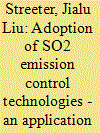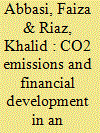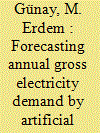|
|
|
Sort Order |
|
|
|
Items / Page
|
|
|
|
|
|
|
| Srl | Item |
| 1 |
ID:
150828


|
|
|
|
|
| Summary/Abstract |
Despite the rising influence of public opinion on government energy policy formulation and implementation, the roles of pro and/or anti-environmental attitudes among residents have not been empirically examined. To quantify time-varying environmental attitudes among local residents, we exploit geo-specific Google search-query data derived from Internet-based “big data” and verify through ordinary least squares regression outcomes regarding environmental behavior. For the purpose of drawing policy implications, we revisit decisions by state governments of the United States to adopt three well-known green electricity policies: renewable energy portfolio, net metering rules, and public benefit funds. As some states have not yet adopted some (or any) of these policies, unlike previous studies, we handle the issue by examining right-censored data and applying a duration-based econometric method called the accelerated failure time model. We found state residents’ environmental attitudes to have statistically significant roles, after controlling for other traditional time-varying policy adoption factors. Interestingly, the extent to which anti-environmental attitudes affect a state’s policy adoption differs across green energy policies, and knowing this can help a local government formulate better-tailored environmental policy. In particular, researchers can use our method of incorporating citizens’ environmental attitudes to discuss relevant issues in the field of energy policy.
|
|
|
|
|
|
|
|
|
|
|
|
|
|
|
|
| 2 |
ID:
150831


|
|
|
|
|
| Summary/Abstract |
Using data on coal-fired electric power plants, this article investigates the contributing factors affecting the investment decisions on flue-gas desulfurization (FGD), a capital-intensive emission control technology. The paper makes two contributions to the literature. First, the public regulatory status of electric power plants is found to have a strong influence on whether FGD investment is made. Compared to deregulated power plants, those that are still under rate-of-return regulations by Public Utility Commissions are more likely to install FGD. Second, a higher rate of inspections of polluting facilities (not just electric utility power plants) in a state in the previous year is associated with a higher probability of power plants adopting FGD this year. In addition, sulfur content of coal and plant size are both positively associated with the likelihood of FGD installation. The service length of boilers is negatively associated with the likelihood.
|
|
|
|
|
|
|
|
|
|
|
|
|
|
|
|
| 3 |
ID:
150829


|
|
|
|
|
| Summary/Abstract |
This paper uses air pollution emissions data for the years 2002, 2005, 2008, and 2011 to estimate monetary damages due to air pollution exposure for PM2.5, SO2, NOx, NH3, and VOC from electric power generation, oil and gas extraction, coal mining, and oil refineries. In 2011, damages associated with emissions from these sectors totaled 131 billion dollars (in 2000$), with SO2 emissions from power generation being the largest contributors to social damages. Further, damages have decreased significantly since 2002, even as energy production increased, suggesting that, among other factors, policies that have driven reductions in emissions have reduced damages. The results of this analysis highlight the spatial heterogeneity of the impacts associated with the emissions of a given pollutant. In the past, environmental regulations have assumed that the benefits of air emissions reductions are homogenous across source location. This analysis suggests that policy designs that account for spatial differences in the impacts of air emissions could result in more effective environmental regulation. Accounting for such spatial heterogeneity in the benefits of policies would be akin to accounting for differences in compliances costs across states, which the EPA did when establishing the state emissions standards for the Clean Power Plan rule.
|
|
|
|
|
|
|
|
|
|
|
|
|
|
|
|
| 4 |
ID:
150824


|
|
|
|
|
| Summary/Abstract |
This paper explores the influence of economic and financial development on carbon emissions in a small emerging economy. The study employs ARDL approach to investigate the long run relationship between carbon emissions and a set of economic and financial variables, an Error Correction Model (ECM) to capture the short run dynamics, Granger causality in an augmented VAR framework to check the causality direction, and variance decomposition based on an estimated Vector Error Correction Model (VECM) to determine the relative contributions of economic and financial variables to the evolution of per capita carbon emissions. The periods considered were the full sample (1971–2011), and a reduced sample sub-period (1988–2011) that corresponded to greater liberalization and financial sector development. The financial variables played a role in emission mitigation only in the latter period where greater degree of liberalization and financial sector development occurred. Even then the relative magnitude of emissions mitigation attributable to financial variables was much smaller compared to the emissions raising impact of rising per capita incomes. This underscores the need for adopting other mitigation policies for reducing carbon footprints in those emerging economies where a sufficient degree of financial deepening and financial sector development has not yet taken place.
|
|
|
|
|
|
|
|
|
|
|
|
|
|
|
|
| 5 |
ID:
150827


|
|
|
|
|
| Summary/Abstract |
Renewable energies are eco-friendly and sustainable. However, their development faces two critical issues: the uncontrollable generation variability, and the high levelized cost. These two issues impede the development of renewables substitution for a government from lacking of clearly argument of how to promote renewables substitution, and what is the role of traditional generation resources should play to back up the renewable energies in a target year. This study aims to depict the possibility of the concerned topic from the aspects of economy, security, and environment, taking a top–down viewpoint of policy-making to address an energy supply problem, and proposes an Energy Supply-Mix Model by considering the complimentary and substitution possibilities between renewable and non-renewable energies, and also among the renewable energies. The solution provides an overall assessment of three aspects under the conditions of supply and demand balance, desired generation percentage of renewable energies, and also ensure no shortage in peak-hour demand. Parametric analysis on the carbon tax is particularly conducted for policy making reference.
|
|
|
|
|
|
|
|
|
|
|
|
|
|
|
|
| 6 |
ID:
150800


|
|
|
|
|
| Summary/Abstract |
We performed a comprehensive and internally consistent assessment of the energy performance of the full range of electricity production technologies in the United Kingdom, integrating the viewpoints offered by net energy analysis (NEA) and life cycle assessment (LCA). Specifically, the energy return on investment (EROI), net-to-gross energy output ratio (NTG) and non-renewable cumulative energy demand (nr-CED) indicators were calculated for coal, oil, gas, biomass, nuclear, hydro, wind and PV electricity. Results point to wind, and to a lesser extent PV, as the most recommendable technologies overall in order to foster a transition towards an improved electricity grid mix in the UK, from both points of view of short-term effectiveness at providing a net energy gain to support the multiple societal energy consumption patterns, and long-term energy sustainability (the latter being inversely proportional to the reliance on non-renewable primary energy sources). The importance to maintain a sufficient installed capacity of readily-dispatchable gas-fired electricity is also recognised.
|
|
|
|
|
|
|
|
|
|
|
|
|
|
|
|
| 7 |
ID:
150823


|
|
|
|
|
| Summary/Abstract |
The energy-efficiency gap has been high on research and policy agendas for several decades. Incentive schemes such as subsidies, taxes and bonus-malus schemes are widely used to promote energy-efficient appliances. Most research, however, considers instruments in isolation, and only rarely in the context of political constraints on instrument use, or for alternative policy goals. This paper presents a methodology for the optimal design of incentive schemes based on the minimisation of Dead Weight Loss for different policy goals and policy restrictions. The use of the methodology is illustrated by designing optimal combinations of taxes and subsidies in Spain for three types of appliance: dishwashers, refrigerators and washing machines. The optimal policies are designed subject to different policy goals such as achieving a fixed reduction in emissions or a certain increased market share for efficient appliances, and for policy constraints such as budget neutrality. The methodology developed here can also be used to evaluate past and current incentive schemes.
|
|
|
|
|
|
|
|
|
|
|
|
|
|
|
|
| 8 |
ID:
150821


|
|
|
|
|
| Summary/Abstract |
Growing power demand, fuel availability and prices, technology changes, the environmental impacts of energy consumption, the changing regulatory environments and the uncertainties around such elements make the planning for optimal power mix a challenging task. The diversity approach is advocated as a most appropriate planning methodology for the optimal energy mix (Hickey et al., 2010). Shannon Wiener Index (SWI), which is the most cited diversity metric has been used to assess power systems diversity mainly from an energy perspective. To our best knowledge, there is no rigorous justification why energy has been the main variable used in diversification exercises rather than other variables such as capacity. We use a stylized power generation framework to show that diversity based on energy or capacity could lead to different outcomes in terms of vulnerability to fuel exposure, among others. We also introduce a Shannon Wiener Index ratio (SWIR) that we believe captures better the diversity of a power system compared to the standard SWI.
|
|
|
|
|
|
|
|
|
|
|
|
|
|
|
|
| 9 |
ID:
150803


|
|
|
|
|
| Summary/Abstract |
Driving restriction policies have been implemented in some large Chinese cities to cope with severe urban smog pollution. We explored the roles of policy acceptance and other factors in commuters' transport mode decisions, based on the Theory of Planned Behavior. A questionnaire survey was conducted in Tianjin, China. A structural equation model was developed to test eight hypotheses, two of which were rejected. The results indicate that a driving restriction policy alone cannot effectively motivate commuters to use public transport if the policymakers fail to improve public transport, enhance commuters' awareness of consequences, increase commuters' perceived behavior control, and encourage car owners to change driving behavior. Comparisons between car owners and non-owners indicated that car owners view driving restriction policy and public transport more negatively. These negative views could be a barrier for the promotion of public transport among car owners. In addition, attitude toward public transport was found to have positive correlation with commuting time.
|
|
|
|
|
|
|
|
|
|
|
|
|
|
|
|
| 10 |
ID:
150810


|
|
|
|
|
| Summary/Abstract |
This paper investigates the effect of OPEC production decisions (increase, cut, maintain) on both WTI and Brent crude oil prices between Q1 1991 and Q1 2015 by employing the event study methodology and by using two indices as benchmarks (BCI and S&P GSCI). We employ an EGARCH model to take into account the high volatility of oil prices and some stylized facts characterizing this volatility. We find that the impact of OPEC’s announcements on oil prices (i)evolves over time and among decisions, (ii) is more significant for production cut and maintain, (iii) is different for WTI and Brent prices, and (iv) is sensitive to the benchmark index. Moreover, OPEC’s decisions depend on the exploration and extraction cost of more expensive/unconventional oil resources.
|
|
|
|
|
|
|
|
|
|
|
|
|
|
|
|
| 11 |
ID:
150832


|
|
|
|
|
| Summary/Abstract |
Economic network regulation increasingly use quantitative performance models (from econometrics and engineering) to set revenues. In theory, high-powered incentive regulation, such as revenue-caps, induces firms to cost-efficient behavior independent of underlying model. However, anecdotal evidence shows regulated firms occasionally maintaining cost-inefficiency under incentive regulation even under slumping profitability. We present a model for firm-level efficiency under a regime with a probability of failure explaining this phenomenon. The model is based on the hypothesis that the regulatory choice of method can be associated with intrinsic flaws leading to judicial repeal and replacement of it by a low-powered regime. The results show that the cost efficiency policy is proportional to the type of firm (cost of effort), value of time (discount factor) and the credibility of the method (risk of failure). A panel data set for 2000–2006 for 128 electricity distributors in Sweden is used to validate the model predictions (radical productivity slowdown, failing profitability and efficiency) at the launch and demise of a non-credible regulation method. The work highlights the fallacy of viewing incentive regulation as a method-independent instrument, a result applicable in any infrastructure regulation.
|
|
|
|
|
|
|
|
|
|
|
|
|
|
|
|
| 12 |
ID:
150804


|
|
|
|
|
| Summary/Abstract |
Our society derives a quantifiable benefit from electric power. In particular, forced outages or blackouts have enormous consequences on society, one of which is loss of economic surplus. The society relies on having a continuous supply of electrical energy. Some customers may willingly risk this continuous supply and participate in demand management programs for electrical power. If the power system grid is in trouble, electric utilities need to have demand relief. Customers willing to reduce their demand to help the system can receive an incentive fee for helping the utilities. Demand relief can be system wide or location specific. Sometimes it can be more effective to fix the electrical demand vs. supply imbalance from the demand side. The value of demand management contracts is greatly affected by customer location. Inclusion of locational attributes into the contract design procedure increases the effectiveness of the contracts by helping a utility get more value from its demand management programs. Independent System Operators and regulators, among others, can also benefit from effective demand management. This paper will investigate how this type of demand management contracts can help the electricity sector both in regulated and deregulated environments.
|
|
|
|
|
|
|
|
|
|
|
|
|
|
|
|
| 13 |
ID:
150805


|
|
|
|
|
| Summary/Abstract |
This paper investigated the impacts of global oil price shocks on the whole metal market and two typical metal markets: copper and aluminum. We applied the autoregressive conditional jump intensity (ARJI) model, combining with the generalized conditional heteroscedasticity (GRACH) method, to describe the volatility process and jump behavior in the global oil market. We separated the oil price shocks into positive and negative parts, to analyze whether oil price volatility had symmetric impacts on China’s metal markets. We further used the likelihood ratio test to examine the symmetric effect of oil price shocks. In addition, we considered the jump behavior in oil prices as an input factor to investigate how China’s metal markets are affected when jumps occur in the global oil market, in contrast to the existing research paying little attention to this issue. Our results indicate that crude oil price shocks have significant impacts on China's metal markets and the impacts are symmetric. When compared with aluminum, copper is more easily affected by oil price shocks.
|
|
|
|
|
|
|
|
|
|
|
|
|
|
|
|
| 14 |
ID:
150801


|
|
|
|
|
| Summary/Abstract |
An increasing block tariff (IBT) has been implemented nationwide in the residential sector in China since 2012. However, knowledge about IBT design is still limited, particularly how to determine the electricity volume for the first block of an IBT scheme. Assuming the first block should be set based on some measure of electricity poverty; we attempt to model household electricity demand such that the range of basic needs can be established. We show that in Chinese households there exists a threshold for electricity consumption with respect to income, which could be considered a measure of electricity poverty, and the threshold differs between rural and urban areas. For rural (urban) families, electricity consumption at the level of 7th (5th) income decile households can be considered the threshold for basic needs or a measure of electricity poverty since household electricity demand in rural (urban) areas does not respond to income changes until after 7th (5th) income decile. Accordingly, the first IBT block for some provinces (e.g., Beijing) appears to have been set at a level that is too high. Over time however, given continued rapid growth, the IBT will begin to better reflect actual basic needs.
|
|
|
|
|
|
|
|
|
|
|
|
|
|
|
|
| 15 |
ID:
150814


|
|
|
|
|
| Summary/Abstract |
We investigate energy security of the Association of Southeast Asian Nations (ASEAN) under the 4-A’s framework. The ASEAN Economic Community (AEC) agreement launched in 2015 renewed a regional focus on energy security and sustainability. We employ an analytic framework to quantitatively assess progress in different categories including availability, acceptability, affordability, and applicability. Key metrics include the documentation of CO2 emissions, energy access measures, and energy supply reserves from 2005–2010. We identify relevant energy indicators using high quality historical data from the IEA and World Bank. We find that ASEAN made little progress toward establishing energy security in the previous five-year planning period (2005–2010) as it regressed in most categories except applicability. Therefore, we suggest that increased development of renewable energy and energy efficiency technologies would move ASEAN in a positive direction toward achieving energy security and sustainable energy policy goals.
|
|
|
|
|
|
|
|
|
|
|
|
|
|
|
|
| 16 |
ID:
150822


|
|
|
|
|
| Summary/Abstract |
In this study we aim at providing an analytical framework for Turkey to study the macroeconomics and environmental impacts of the existing coal subsidization scheme. To this end we develop a regionally differentiated applied general equilibrium model spanning over 2015–2030. Our analytical apparatus focuses exclusively on the fiscal implications as well as the environmental repercussions of the removal of the subsidies on greenhouse gas emissions. With the aid of a set of alternative policy scenarios against a “business as usual” path, we study the regional and sectorial performances of growth, employment, investment and capital accumulation, consumption/welfare and trade balance. Our results indicate that by simple elimination of the coal subsidization scheme, Turkey can reduce its aggregate gaseous emissions by as much as 5% without a significant loss in its GDP.
|
|
|
|
|
|
|
|
|
|
|
|
|
|
|
|
| 17 |
ID:
150820


|
|
|
|
|
| Summary/Abstract |
In this work, the annual gross electricity demand of Turkey was modeled by multiple linear regression and artificial neural networks as a function population, gross domestic product per capita, inflation percentage, unemployment percentage, average summer temperature and average winter temperature. Among these, the unemployment percentage and the average winter temperature were found to be insignificant to determine the demand for the years between 1975 and 2013. Next, the future values of the statistically significant variables were predicted by time series ANN models, and these were simulated in a multilayer perceptron ANN model to forecast the future annual electricity demand. The results were validated with a very high accuracy for the years that the electricity demand was known (2007–2013), and they were also superior to the official predictions (done by Ministry of Energy and Natural Resources of Turkey). The model was then used to forecast the annual gross electricity demand for the future years, and it was found that, the demand will be doubled reaching about 460 TW h in the year 2028. Finally, it was concluded that the approach applied in this work can easily be implemented for other countries to make accurate predictions for the future.
|
|
|
|
|
|
|
|
|
|
|
|
|
|
|
|
| 18 |
ID:
150817


|
|
|
|
|
| Summary/Abstract |
Growing shortfall of electricity in Pakistan affects almost all sectors of its economy. For proper policy formulation, it is imperative to have reliable forecasts of electricity consumption. This paper applies Holt-Winter and Autoregressive Integrated Moving Average (ARIMA) models on time series secondary data from 1980 to 2011 to forecast total and component wise electricity consumption in Pakistan. Results reveal that Holt-Winter is the appropriate model for forecasting electricity consumption in Pakistan. It also suggests that electricity consumption would continue to increase throughout the projected period and widen the consumption-production gap in case of failure to respond the issue appropriately. It further reveals that demand would be highest in the household sector as compared to all other sectors and the increase in the energy generation would be less than the increase in total electricity consumption throughout the projected period. The study discuss various options to reduce the demand-supply gap and provide reliable electricity to different sectors of the economy.
|
|
|
|
|
|
|
|
|
|
|
|
|
|
|
|
| 19 |
ID:
150816


|
|
|
| 20 |
ID:
150818


|
|
|
|
|
| Summary/Abstract |
Energy, whether from electricity, natural gas, heating oil, propane, kerosene, or wood, is essential for the well-being of many Americans, yet those who spend more than 10 percent of their income of energy services can be considered “fuel poor.” This study assesses the extent and severity of fuel poverty in Vermont. It analyzes energy burdens in Vermont by household income deciles, using data from the Census Bureau's American Community Survey. Approximately 71,000 people suffered from fuel poverty in Vermont in 2000, and in 2012 the number rose to 125,000, or one in five Vermonters. Startlingly, fuel poverty grew 76 percent during this period. Excess winter deaths, caused potentially by fuel poverty, kill more Vermonters each year than car crashes. The article then provides 12 policy recommendations based on a small sample of elite semi-structured research interviews. These include suggestions that the Vermont legislature better fund investments in weatherization among low-income households; that community groups and social service agencies scale up the training of energy efficiency coaches; that state agencies endorse improvements in housing efficiency and appropriate fuel switching; and that utilities and fuel providers offer extra assistance for disconnected households and allow for on-bill financing of efficiency improvements.
|
|
|
|
|
|
|
|
|
|
|
|
|
|
|
|
|
|
|
|
|